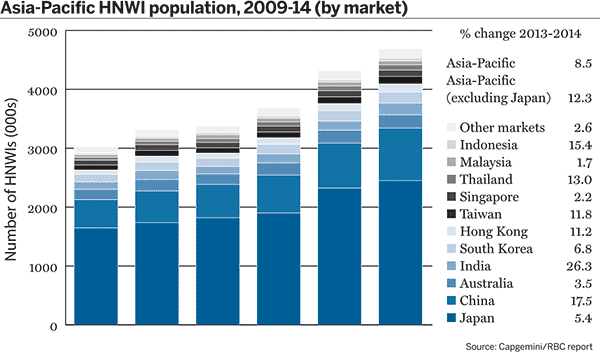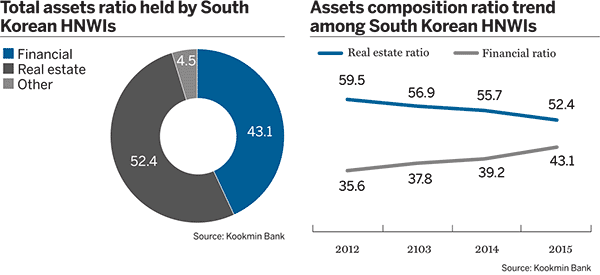Good, but could be great: wealth management in South Korea
South Korea has a large and vibrant wealth management sector, but it has yet to reach its full potential. Michael Imeson speaks to industry experts to assess how the country and its domestic financial institutions can bridge the gap between them and their Asia-Pacific peers.
The wealth management industry in South Korea is in good health, benefiting from rising numbers of affluent people who have a desire to invest their assets and get even richer.
Editor's choice
According to the Asia-Pacific Wealth Report 2015, published by Capgemini and RBC Wealth Management in September, South Korea has the fifth largest population of high-net-worth individuals (HNWIs) in the region. The total stood at 189,000 at the end of 2014, 6.8% higher than at the end of 2013.
As for the investable wealth held by HNWIs, South Korea ranks seventh in the region. The total wealth invested amounted to $516bn at the end of 2014, 8.2% higher than at the end of 2013.
These are respectable statistics, but they must be put in perspective. “While comprising many markets, Asia-Pacific is a concentrated region when it comes to HNWIs, with more than three-quarters of the region’s HNWIs in the top three markets of Japan, China and Australia,” says David Wilson, head of strategic analysis at Capgemini Financial Services.
“These larger markets aside, South Korea is a mid-sized high-net-worth market in Asia-Pacific, having the fifth highest number of HNWIs, representing 4% of the region’s HNWIs. During the crisis, it was one of the most resilient markets in the region, with the HNWI population only dropping 11%, compared with the regional average of 14.2%,” he says.
“Since the low-point in 2008, South Korea’s HNWI population has grown 80% overall, demonstrating strong post-crisis performance, especially as the crisis shock on the population figures was not too large to begin with.”
Real estate reliance
Seo Young Lee, partner and head of South Korea at consultants Oliver Wyman, says Capgemini’s survey tallies with his understanding of the size of the wealth management sector in the country, based on the typical definition of a HNWI, which is someone with assets of more than $850,000.
“The Korean wealth management sector is still developing. Relative to the size of the country’s economy, the sector is undergoing a stage of sophistication. About 55% of total investable assets are in real estate, and although this has been falling it is still a lot higher than we see in mature markets where people have access to a broad suite of investment products,” he says.
“As for the financial assets HNWIs hold, about half are held in savings accounts. That means about 75% of their total assets are held in real estate or bank deposits, leaving only 25% to be invested in the traditional wealth management products favoured by investors in more mature markets.”
The popularity of real estate as an investment is due to high property price inflation in South Korea, stimulated in part by successive government polices to support the housing market. The relative lack of interest in financial assets such as equities, bonds and mutual funds is partly due to the fact that, compared with the size of the country’s economy, the capital markets are not deep. There is a high level of speculation and volatility, reducing their attraction for long-term savers.
The regulations do not help either. “Financial institutions can only charge fees if they are linked to saleable products, they cannot charge for advice,” says Mr Lee. “In many cases this leads to asset churn, with wealth managers selling products to generate fees for their firm.
“And although capital controls on overseas investments are not as strict as they were, flows overseas are reported to the government as part of the government’s oversight of capital movements.”
Nevertheless, South Koreans are investing overseas. The most popular foreign investments, in order of priority, says Mr Lee, are equities (accounting for about 40% of the total) in both developed and emerging markets; real estate; direct business investment; and government bonds, such as US treasuries.
The main players
The biggest domestic players in the South Korean private wealth management market are Shinhan Bank, Hana Bank, WooriBank and Kookmin Bank, plus other financial institutions such as Samsung, Mirae Asset, Daewoo, Korea Investment and NH Securities.
A number of foreign banks entered the market some years ago but in most cases they did not understand the local nuances, failed to establish sufficient scale, and have since pulled out, with a few exceptions, such as Citi and Standard Chartered.
“Wealth management is relationship based, so foreign wealth managers who want to enter the market here need to recruit qualified relationship managers who speak Korean very well, and understand the specific and differentiated asset management needs at the same time, which is difficult,” says Huntaek Jung, principal at Roland Berger, the German strategy consultants that opened an office in Seoul in 2012.
Seb Dovey, managing partner of the Scorpio Partnership, a London market research consultancy, says South Korea has been a “notoriously difficult” market for international private banks to penetrate. “In some ways, in spite of the strength and scale of the market, South Korea has at times been overlooked by the international banks in favour of markets such as China, Taiwan and even Japan,” says Mr Dovey. “Partly, a barrier to access is that Koreans are very much inclined to do business with other Koreans and there is a limited population of private bankers at international banks to meet this need.”
Growth trends
Young Jin Lim, executive vice president of wealth management group at Shinhan Bank, says that according to the statistics he uses, which show similar totals and trends to those from Capgemini/RBC, between 2008 and 2014 South Korea’s HNWI population experienced a combined annual growth rate of 13.7%, growing every year except in 2008. However, between 2013 and 2014, that rate slowed to 8.7%, due to lower interest rates and poorer stock market performance.
“South Korea’s HNWIs invest a high proportion of their wealth in real estate assets rather than financial, but since 2012 there has been in decline in the real estate assets ratio and a corresponding rise in the financial assets ratio,” says Mr Lim (see chart). “This trend is expected to continue for the time being.”
Mr Jung agrees that although the proportion of real estate assets held is high, it is steadily decreasing to be replaced by financial assets. “However, it’s hard for wealth management firms to create a differentiating value proposition to their customers. The key investment products they offer are all similar. The market is not big but the choice of wealth managers is relatively large, so access for customers is easy and that makes it hard for firms to win business,” he says.
“Risk-neutral products are the most popular at the moment”, adds Mr Lim. “Low interest rates and low investment growth have set in, but investors are dissatisfied with riskless low interest assets. Nor do they want to take on too much risk in volatile stock markets. So the trend is towards intermediate risk/intermediate return products, the most popular of which are equity-linked securities.
“One in five HNWIs believe that tax savings and tax benefits are more important than profitability or stability, so they sign up to tax-efficient products.”
Mr Lim says that higher rates of return on certain overseas asset classes have stimulated interest among South Korean investors. The most popular countries to invest in are China due to the stock market boom (although that, of course, has recently been corrected), India and Vietnam for their high economic growth rates, and developed markets such as Canada and New Zealand.
“Consumer technology in Korea is the world’s best,” says Mr Lim. “Banking with smartphones is higher than anywhere else and financial technology vendors want to try out their new products here.”
Scorpio’s Mr Dovey agrees, up to a point. “Technology in the banking sector in general – more centred on the retail market – is very advanced,” he says. “Korea is well recognised as a country with a strong appetite for technologically advanced solutions. However, the wealth management industry is still relatively under-formed, so more advanced technology will take longer to creep into the offering.”
Recent growth drivers
“The South Korean wealth management market is growing at a rapid rate and the two main factors driving this growth are the low-interest-rate environment and the ageing population,” says Justin Pak, a financial services partner at EY.
“Historically, the country has never experienced bank time-deposit rates at the current level, which is between 1% to 2%, and this is forcing individuals to move their money from bank deposits to wealth management products and more risky products such as equities. In addition, average life expectancy has increased significantly and with the ageing population, the need for pension and long-term savings products is increasing.”
Fixed-income funds, exchange-traded funds, equity-linked securities, hedge funds and real estate funds are popular. “In addition, investors in Korea are now able to make direct investments in US equities, overseas fixed-income products through [China’s renminbi qualified foreign institutional investor programme] and UCITs structures [EU collective investment schemes] and overseas hedge funds,” says Mr Pak. “Asset management companies and securities firms are always on the look-out for overseas securities that provide decent returns to investors.”
“South Korea should blossom,” is Mr Dovey’s forecast for the future. “The fundamentals are in place: a strong economy, a strong population of HNWIs and a growing appetite for a fuller wealth management service.” He believes that the market could become as mature as that in Australia, Europe and North America in as little as five to 10 years.
Oliver Wyman’s Mr Lee is less bullish. “For Korea to start looking more like Europe and North America it will take 10 to 20 years, and a number of things would have to change,” he says.
However long it takes, it is clear that the domestic players need step up their capabilities, because it is their prize to lose. “They need to adapt and also assimilate international wealth management standards,” says Mr Dovey. “They should take note of the rise of new internationally recognised private banking solutions of the other regional [Asia-Pacific] banks and they need to decide whether they want to participate in that game. All the ingredients are in place for them to join the race.”




